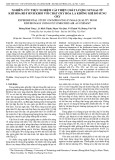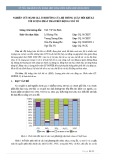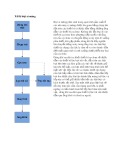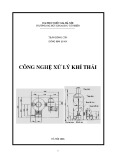
Transport and Communications Science Journal, Vol 75, Issue 09 (12/2024), 2252-2263
2252
Transport and Communications Science Journal
TRAFFIC ORGANIZATION FUNCTION OF VTS SYSTEM IN
REDUCING AIR POLLUTION FROM SHIPS AT SAI GON - VUNG
TAU CHANNEL
Pham Thanh Tuan1,2, Ho Quoc Bang3, Ho Minh Dung2, Nguyen Thoai Tam2*
1Maritime Administration of Ho Chi Minh city, No. 157 Nguyen Tat Thanh Street, District 4,
Ho Chi Minh City, Vietnam
2Institute for Environment and Resources (IER), No. 142 To Hien Thanh, District 10, Ho Chi
Minh City, Vietnam
3Vietnam National University, Linh Trung ward, Thu Duc, Ho Chi Minh City, Vietnam
ARTICLE INFO
TYPE: Research Article
Received: 29/09/2024
Revised: 05/11/2024
Accepted: 10/12/2024
Published online: 15/12/2024
https://doi.org/10.47869/tcsj.75.9.2
* Corresponding author
Email: thoaitam1986@gmail.com; Tel: 0978685382
Abstract. By receiving vessel information, the Vessel Traffic System (VTS) does not only
play an important role in early detect risk of collision to promptly provide information,
instructions but also contribute as a tool to control air emission from ships. Applying the
emission inventory method (bottom-up) to the case of oil tanker Long Phu 16 underway in
Ho Chi Minh City seaport waters shows the possibility of reducing about 17% of air
emissions from the ship in case of involve in VTS participation. In addition, the study also
finds out the potential contribution of VTS as an alternative tool to replace channel-clearance
supporting craft. The results of this study show that through the function of coordinating and
supporting ships with appropriate technical specifications navigating on maritime channels,
VTS can assist to shorten time to navigation and minimize patrol vehicles in high risk areas
of maritime accidents, thereby reducing emissions from shipping operations significantly.
Keywords: VTS; emission inventory; air pollution; shipping.
2024 University of Transport and Communications

Tạp chí Khoa học Giao thông vận tải, Tập 75, Số 9 (12/2024), 2252-2263
2253
Tạp chí Khoa học Giao thông vận tải
CHỨC NĂNG ĐIỀU PHỐI, PHÂN LUỒNG GIAO THÔNG CỦA HỆ
THỐNG VTS TRONG GIẢM THIỂU Ô NHIỄM KHÔNG KHÍ TỪ
TÀU THUYỀN TRÊN LUỒNG HÀNG HẢI SÀI GÒN – VŨNG TÀU
Phạm Thanh Tuấn1,2, Hồ Quốc Bằng3, Hồ Minh Dũng2, Nguyễn Thoại Tâm2*
1Cảng vụ Hàng hải Thành phố Hồ Chí Minh, Số 157 Nguyễn Tất Thành, Quận 4, Thành phố
Hồ Chí Minh, Việt Nam
2Viện Môi Trường và Tài Nguyên (IER), Số 142 Tô Hiến Thành, Quận 10, Thành phố Hồ Chí
Minh, Việt Nam
3Đại học Quốc gia Thành phố Hồ Chí Minh, Phường Linh Trung, thành phố Thủ Đức, Thành
phố Hồ Chí Minh, Việt Nam
THÔNG TIN BÀI BÁO
CHUYÊN MỤC: Công trình khoa học
Ngày nhận bài: 29/09/2024
Ngày nhận bài sửa: 05/11/2024
Ngày chấp nhận đăng: 10/12/2024
Ngày xuất bản Online: 15/12/2024
https://doi.org/10.47869/tcsj.75.9.2
* Tác giả liên hệ
Email: thoaitam1986@gmail.com; Tel: 0978685382
Tóm tắt. Bằng cách thu nhận thông tin tàu thuyền, Hệ thống giám sát và điều phối giao thông
hàng hải (VTS) không những đóng vai trò quan trọng trong việc phát hiện sớm các nguy cơ
đâm va của tàu thuyền trên biển để kịp thời cung cấp thông tin, chỉ dẫn, khuyến cáo cần thiết
mà còn có thể là công cụ kiểm soát ô nhiễm khí thải từ tàu thuyền. Áp dụng phương pháp
kiểm kê khí thải (từ dưới lên) đối với trường hợp tàu Long Phú 16 vận chuyển xăng dầu hành
trình tại vùng nước cảng biển Thành phố Hồ Chí Minh cho thấy khả năng cắt giảm đến khoảng
17% lượng khí thải phát sinh từ tàu trong thời gian hành trình nếu có sự tham gia điều phối
của Hệ thống VTS. Ngoài ra, nghiên cứu cũng cho thấy tiềm năng đóng góp của Hệ thống
VTS thay thế cho các phương tiện điều tiết, dẹp luồng. Kết quả của nghiên cứu này cho thấy
thông qua chức năng điều phối và hỗ trợ tàu thuyền có thông số kỹ thuật phù hợp hành trình
trên luồng hàng hải, Hệ thống VTS có thể giúp rút ngắn thời gian tàu hành trình và giảm thiểu
phương tiện điều tiết, cảnh giới tại một số khu vực có rủi ro cao về tai nạn hàng hải từ đó
giảm thiểu lượng lớn khí thải phát sinh từ hoạt động của tàu thuyền.
Từ khóa: Hệ thống VTS; kiểm kê; khí thải; tàu thuyền.
2024 Trường Đại học Giao thông vận tải

Transport and Communications Science Journal, Vol 75, Issue 09 (12/2024), 2252-2263
2254
1. ĐẶT VẤN ĐỀ
Hàng năm khối lượng hàng chuyên ch trên Thế giới do vận tải biển đảm nhiệm đạt hơn
90% [1]. Theo Tổ chức hàng hải quốc tế (IMO) thì Hệ thống giám sát và điều phối giao thông
hàng hải (VTS) cần được ưu tiên thiết lập khu vực đông mật độ tàu thuyền cũng như tiềm ẩn
nhiều nguy cơ đâm va nhằm tăng cường an toàn, hiệu quả hàng hải và bảo vệ môi trường [2].
Sự đóng góp của VTS về giảm thiểu các sự cố, tai nạn hàng hải phần lớn do yếu tố con người
gây ra đã được F. Crestelo Moreno và cộng sự nghiên cứu đánh giá định tính vào năm 2022 tuy
nhiên sự đóng góp của Hệ thống VTS trong việc kiểm soát khí thải từ tàu thuyền chưa được
nghiên cứu rõ ràng [3]. Bài báo này sử dụng phương pháp kiểm kê khí thải cho trường hợp tàu
vận chuyển xăng dầu hành trình theo tuyến luồng hàng hải Sài Gòn – Vũng Tàu dưới các kịch
bản khác nhau để tìm hiểu tiềm năng của việc sử dụng Hệ thống VTS trong việc kiểm soát khí
thải từ tàu thuyền.
Tuyến luồng hàng hải Sài Gòn - Vũng Tàu phần lớn đi qua khu vực cảng biển Thành phố
Hồ Chí Minh có đông mật độ dân cư và tàu thuyền hoạt động phục vụ phát triển kinh tế - xã
hội phía Nam nên đi cùng nhiều rủi ro về vấn đề ô nhiễm môi trường từ hoạt động của tàu
thuyền [4]. Do các hạn chế về năng lực ứng phó sự cố, tầm nhìn xa khi tàu hành trình, yếu tố
con người (mệt mỏi của thuyền viên khi đi ca đêm) nên tại khu vực cảng biển Thành phố Hồ
Chí Minh quy định tàu ch dầu, sản phẩm của dầu mỏ và hóa chất độc hại có hàng không được
hành trình đêm từ 18 giờ 00 đến 05 giờ 00 sáng hôm sau (theo Phụ lục 6 Nội quy cảng biển
Thành phố Hồ Chí Minh) [5]. Dựa trên thông tin thu thập được từ tàu thuyền trước khi tàu đến
cảng, VTS sẽ nhận biết tàu có khả năng chạy lấn đêm để chỉ định điều động neo đậu tại khu
neo Vũng Tàu chờ vào cảng đến sáng hôm sau hoặc điều phối để hỗ trợ tàu thuyền giảm thiểu
thời gian hành trình vào cảng kịp thời.
2. PHƯƠNG PHÁP LUẬN
2.1. Thu thập thông tin
2.1.1. Tuyến hành trình
Khu vực tàu Long Phú 16 hành trình bắt đầu từ phao “0” theo tuyến luồng hàng hải Sài
Gòn - Vũng Tàu hành trình đến bến cảng Tổng kho xăng dầu Nhà Bè sẽ đi qua Vịnh Gành Rái,
sông Thiềng Liềng, sông Lòng Tàu, sông Nhà Bè. Trên cơ s thông số kỹ thuật của tàu và thời
gian tàu hành trình mà VTS sẽ có kế hoạch điều phối tàu phù hợp, cụ thể như sau:
- Đối với tàu thuyền có thông số kỹ thuật phù hợp: được hành trình 1 chiều theo luồng sông
Dừa do đặc điểm bề rộng sông Dừa và tuyến luồng sông Dừa khá hẹp (60m) [5]. Trường hợp
tàu hành trình luồng sông Dừa sẽ rút ngắn quãng đường di chuyển (thay cho sông Lòng Tàu)
và thời gian hành trình. Ngoài ra tại vùng nước cảng biển còn có quy định khu vực hạn chế tốc
độ (từ ngã ba sông Đồng Tranh - sông Lòng Tàu về thượng lưu) nhằm giảm thải khí thải phát
sinh từ tàu thuyền (theo nghiên cứu của Gang Dong và Paul Tae-Woo Lee thì việc hạn chế tốc
độ một trường hợp tàu container điển hình góp phần giảm thiểu 9,15% phát thải sulfur oxide
[6]). Tuyến hành trình của tàu Long Phú 16 được mô tả như sau:

Tạp chí Khoa học Giao thông vận tải, Tập 75, Số 9 (12/2024), 2252-2263
2255
Hình 1. Tuyến hành trình của tàu Long Phú 16. Nguồn: Công ty TNHH MTV Thông tin Điện tử Hàng
hải Việt Nam [7].
Bảng 1. Quãng đường hành trình.
Thông tin
Quãng đường hành trình
72km
(theo luồng Sài Gòn - Vũng Tàu)
64km
(theo luồng sông Dừa)
Nguồn: Cục Hàng hải Việt Nam [8]
- Đối với tàu ch dầu, sản phẩm của dầu mỏ và hóa chất độc hại có hàng không được hành
trình đêm nên cần tính toán thời gian vào cảng phù hợp. Trường hợp không kịp thời gian vào
cảng, điều phối viên VTS sẽ điều phối tàu neo đậu tại khu neo Vũng Tàu để chờ đợi.
2.1.2. Tàu biển
Tàu Long Phú 16 thuộc đối tượng yêu cầu phải trang bị hệ thống nhận dạng tự động (AIS)
qua đó truyền phát các thông tin về thông số kỹ thuật (tĩnh, động) và thông tin chuyến hành
trình đến trạm bờ và tàu thuyền xung quanh theo thời gian thực [9]. Dựa vào thông tin thu thập
được từ tàu thuyền truyền phát đến Hệ thống VTS, điều phối viên VTS có thể thực hiện công
tác điều phối và giám sát quá trình hành hải của tàu thuyền phù hợp nhằm nâng cao hiệu quả
chạy tàu, bảo đảm an toàn hàng hải và bảo vệ môi trường.
Hình 2. Kết nối thông tin AIS. Nguồn: Cảng vụ Hàng hải Thành phố Hồ Chí Minh [10].

Transport and Communications Science Journal, Vol 75, Issue 09 (12/2024), 2252-2263
2256
Hình 3. Trung tâm VTS Sài Gòn - Vũng Tàu. Nguồn: Cảng vụ Hàng hải Thành phố Hồ Chí Minh
[10].
Phương pháp thu thập thông tin AIS từ Hệ thống VTS đã được Hyangsook Lee và cộng sự
áp dụng để kiểm kê khí thải tại cảng biển Incheon vào năm 2020 cho thấy độ tin cậy, chính xác
cao của nguồn thông tin này [11]. Qua thu thập thông tin từ AIS của tàu Long Phú 16 hành trình
vào bến cảng Tổng kho xăng dầu Nhà Bè vào ngày 21/3/2024 ghi nhận như sau:
Bảng 2. Thông tin tàu LONG PHU 16.
Thông tin
Ghi chú
Loại tàu
Tàu xăng dầu
Dữ liệu từ hệ thống nhận dạng tự động
Tốc độ tàu tối đa (cruise)
12 hải lý/ giờ
Trường hợp tàu chạy tắt theo luồng
sông Dừa sẽ là 2 giờ hoặc là 2 giờ 30
phút nếu chạy đường chính
Tốc độ tàu hành trình tốc độ hạn
chế (Reduce speed zone)
8,0 hải lý/ giờ
Thời gian tàu hành trình là 1 giờ 00
phút
Tốc độ điều động (Manoeuvre)
5,0 hải lý/ giờ
Thời gian tàu điều động là 30 phút
Thời gian hành trình (tính từ phao
“0” đầu luồng) đến bến cảng Tổng
kho xăng dầu Nhà Bè
3 giờ 30 phút
Theo luồng tắt sông Dừa
4 giờ
Theo luồng chính
Công suất máy
3900 KW
L35MC-MK6 được sản xuất năm
2000 có vòng quay 210 vòng/ phút
Nguồn: Công ty TNHH MTV Thông tin Điện tử Hàng hải Việt Nam [7]
Trong trường hợp này sẽ thảo luận về sự hỗ trợ của Hệ thống VTS trong các vấn đề sau:
- Tính toán thời gian hành trình của tàu để không hành trình lấn đêm (sau 18 giờ 00).
- Cung cấp dịch vụ hỗ trợ hành hải (Traffic Organization Service) để hỗ trợ tàu hành trình
luồng sông Dừa nhằm giảm thiểu quãng đường di chuyển (rút ngắn 8km), thời gian hành trình
(rút ngắn 30 phút với tốc độ 12 hải lý/ giờ). Do luồng sông Dừa có bề rộng luồng hẹp, chỉ hạn
chế tàu biển hành trình 1 chiều nên cần công tác điều tiết, phân luồng giao thông hàng hải phù
hợp.
2.2. Phương pháp kiểm kê khí thải
Hiện nay có 02 phương pháp chính phục vụ kiểm kê khí thải từ tàu thuyền gồm từ trên
xuống (top-down) - dữ liệu tiêu thụ nhiên liệu do chủ tàu/người khai thác báo cáo; phương pháp
từ dưới lên (bottom-up) - dữ liệu về thông số kỹ thuật của tàu thuyền với dữ liệu hoạt động của







![Các loại nguồn thải chất gây ô nhiễm môi trường khí [nêu chi tiết/ đầy đủ/ chuẩn nhất]](https://cdn.tailieu.vn/images/document/thumbnail/2020/20200220/nguathienthan3/135x160/3661582192448.jpg)




![Tài liệu Vi sinh vật môi trường [Mới nhất]](https://cdn.tailieu.vn/images/document/thumbnail/2025/20251123/ngkimxuyen/135x160/21891763953413.jpg)
![Sổ tay truyền thông Phân loại chất thải rắn sinh hoạt trên địa bàn tỉnh Quảng Nam [Chuẩn nhất]](https://cdn.tailieu.vn/images/document/thumbnail/2025/20251114/kimphuong1001/135x160/1701763094001.jpg)


![Quản lý chất thải nguy hại: Sổ tay Môi trường [Chuẩn nhất]](https://cdn.tailieu.vn/images/document/thumbnail/2025/20251029/kimphuong1001/135x160/9011761720170.jpg)









